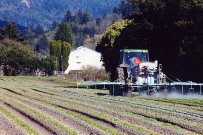Siskiyou Land Conservancy President and Program Director Greg King recently added some clarity to the Klamath dam deals in the letters section of the North Coast Journal. The entire letter is pasted below.
The letter was in response to the cover story, by Journal editor Hank Sims, on the Klamath water and dam deals.
On Sunday, Oct. 18, Hoopa Valley Tribal Chairman Leonard Matsen expressed his council’s concerns over the Klamath deals in an op-ed in the Sacramento Bee.
As always, longtime Klamath resident and activist Felice Pace provides excellent updates on his Klamblog.
Here is King’s letter:
No Settlement
Editor:
Thanks to Hank Sims for producing one of the better journalistic examinations of the Klamath deal (“The Klamath Settlement,” Oct. 8). However, the article’s subhead — “weighing the pros and cons of a proposal to end the crisis on our most important river” — is misleading.
The Klamath Basin Restoration Agreement (KBRA) and the Klamath Hydro Agreement (KHA) are crafted to be “indivisible” from each other. That is, without the KBRA there will be no dam removal. After immersing in these negotiations for nearly three years I realized that these efforts are more about allocating water than removing dams. Rather than “ending” the Klamath crisis these deals could exacerbate it.
As the Journal noted, early into its regime the Bush Administration strong-armed Klamath scientists into denying that a lack of water would harm fish. Klamath farmers tended a half-million acres of crops in the upper basin, and the Oregon agricultural industry was an important Republican constituency. The resulting massive water delivery to upriver Klamath farmers in 2002 violated the Endangered Species Act and decimated 70,000 salmon, the largest adult fish kill in U.S. history.
Appalling as the fish kill was, it afforded farmers a real threat that allowed injection of their demands for “water security” into a dam removal negotiation that had nothing to do with upriver farming. The questions, though not verbalized, were hardly rhetorical: You want to avoid another fish kill? You want the president, who happens to be in our pocket, to sign dam removal legislation? Then we get a seat at the table and an unprecedented guarantee of water, even though we receive no water or flood control from the dams.
The result is a deal that, as Sims points out, guarantees water for farmers but not for fish. Farmers get first draw, the fish get what’s left. The KBRA could actually subvert the Endangered Species Act. Current court-ordered ESA protections disallow flows at Iron Gate from going below 1,000 cubic feet per second (cfs). A close look at the WRIMS model (cited by the Journal) shows that flows under the Agreement could actually run as low as 414 cfs. The 2002 fish kills flows fluctuated at around 700 cfs. Dr. Thomas Hardy — whose eventual support for the KBRA was highly qualified — has said he could never support Klamath flows this low.
Then there’s the requirement that California voters pass a $250 million bond to help pay for dam removal. Even if voters were inclined to tax themselves (which the last election showed they are not), Governor Schwarzenegger has promised that he will fight any water bond that does not include two new dams and a peripheral canal on the Sacramento-San Joaquin ecosystem. Environmentalists could actually find themselves fighting California’s funding of Klamath dam removal in order to protect the Sacramento River.
Greg King, President/Program Director, Siskiyou Land Conservancy

